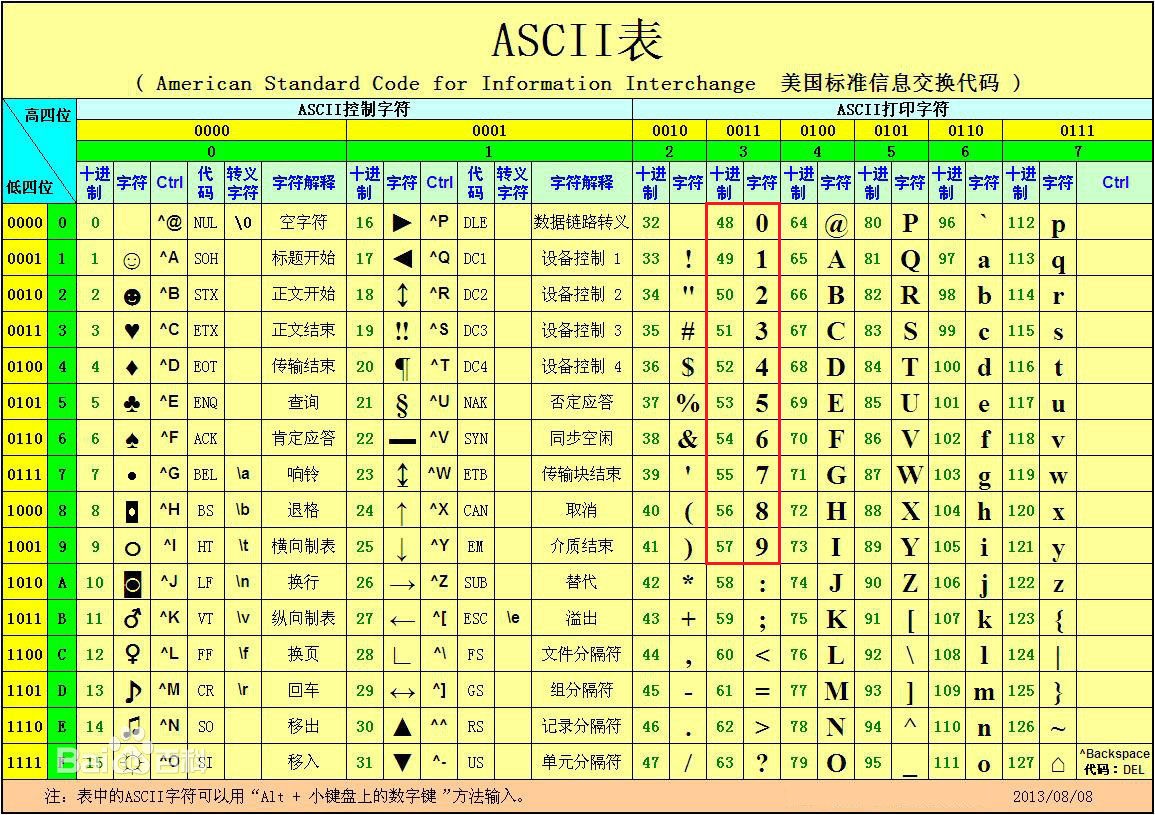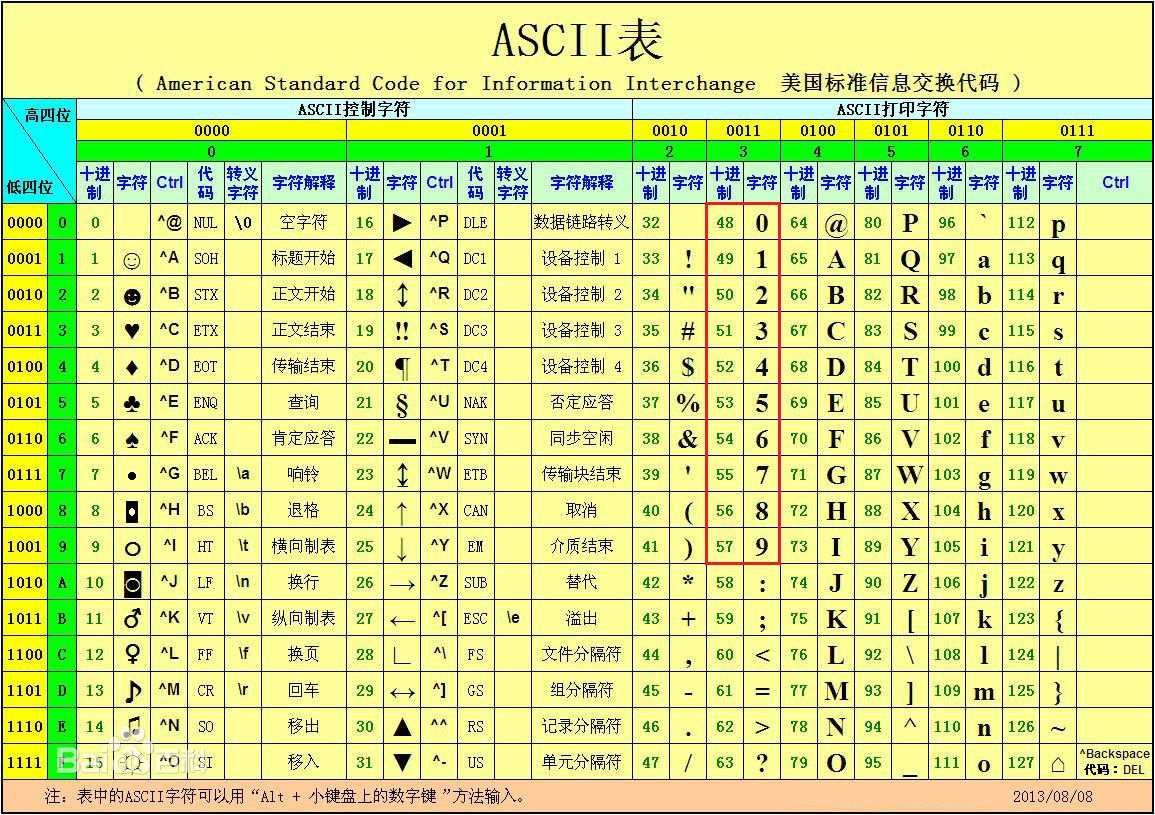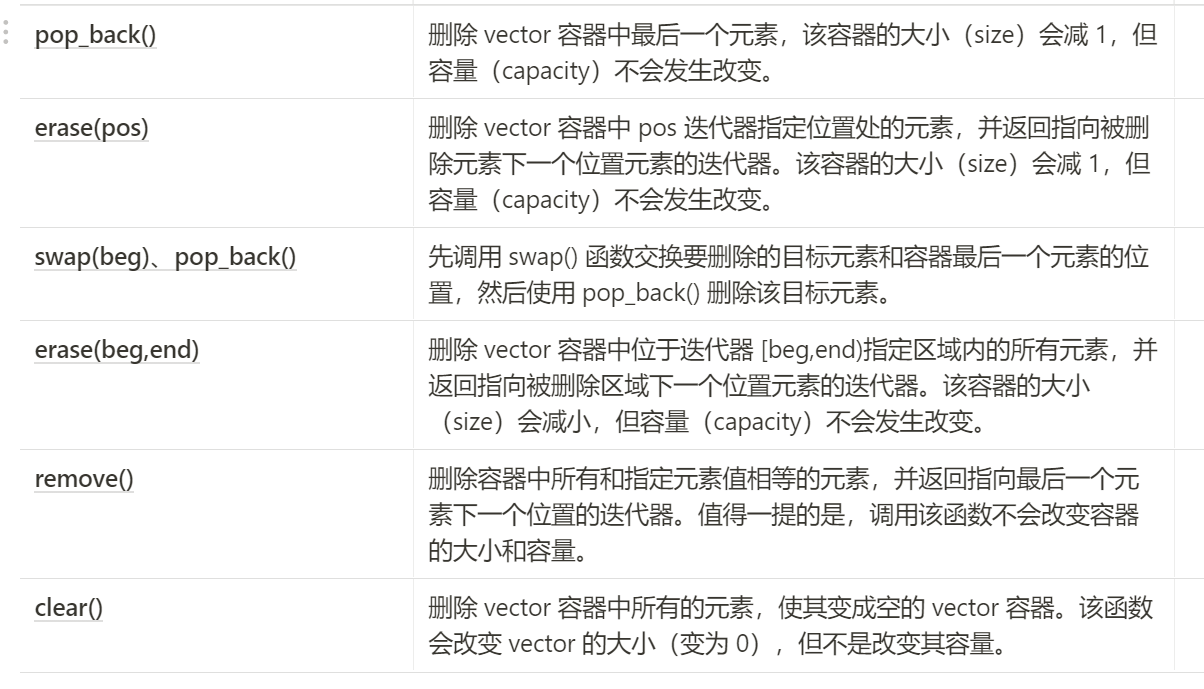比较乱,有空再整理~
C++学习笔记
命名空间的using声明
一般用到标准输入输出流的时候,库函数属于命名空间std,用作std::cout、std::cin
或者在开头声明:using namespace std;
或者单独声明:using std::cin;、using std::cout;
类型说明符auto
auto:让编译器去分析表达式所属的类型。
1
2
| auto cnt = 0;
auto pi = 3.14;
|
类型指示符decltype
decltype是declare type的缩写,译为声明类型。
能从表达式的类型推断出变量的类型,如:
1
| decltype(sizeof(arr)) length;
|
基于范围的for语句(range for)
for (declaration : expression)
statement
1
2
3
4
5
6
7
8
9
10
11
12
13
14
|
for (auto c : str)
{
cout << c << “ ”;
}
cout << str;
for (auto &c : str)
{
c = toupper(c);
}
cout << str;
|
cpp中类相关
静态成员变量和静态成员函数
类中定义的静态成员、函数,为整个类所有,所有对象共享。所以可以直接通过类名访问,当然也可以通过对象直接访问。
静态成员函数只能直接访问静态变量和静态函数(因为不能实例化)。
1
2
3
4
5
6
7
8
9
10
11
12
13
14
15
16
17
18
19
20
21
22
23
24
25
26
27
28
29
30
31
32
33
| #include <iostream>
#include <string>
using namespace std;
class test
{
private:
static int m_value;
public:
test()
{
m_value++;
}
static int getValue()
{
return m_value;
}
};
int test::m_value = 0;
int main()
{
test t1;
test t2;
test t3;
cout << "test::m_value2 = " << test::getValue() << endl;
cout << "t3.getValue() = " << t3.getValue() << endl;
system("pause");
}
|

|
静态成员函数 |
普通成员函数 |
| 所有对象共享 |
yes |
yes |
隐含this指针 |
no |
yes |
| 访问普通成员变量(函数) |
no |
yes |
| 访问静态成员变量(函数) |
yes |
yes |
类的继承
相应的构造函数也可以继承。
1
2
3
4
5
6
7
8
9
10
11
12
13
14
15
16
| class Gene
{
public:
int index;
int dir;
Gene(int _index, int _dir) :index(_index), dir(_dir) {};
};
class Res :public Gene
{
public:
int station;
double st;
double pt;
Res(int _station, int _index, int _dir, double _st, double _pt) :Gene(_index, _dir), station(_station), st(_st), pt(_pt) {};
string fout()const;
};
|
读取CSV文件,表格型
1
2
3
4
5
6
7
8
9
10
11
12
13
14
15
16
| ifstream inFile(filePath, ios::in);
string lineStr;
getline(inFile, lineStr);
while (getline(inFile, lineStr))
{
stringstream ss(lineStr);
string str;
vector<string> lineArray;
while (getline(ss, str, ','))
lineArray.push_back(str);
strArray.push_back(lineArray);
}
|
判断字符串是否是数字
c++比较愚蠢,只能一个字符一个字符的判断
方法一:判断字符的ASCII范围
(数字的ASCII范围为48~57)


1
2
3
4
5
6
7
8
9
10
11
12
13
14
15
16
| bool AllisNum(string str)
{
for (int i = 0; i < str.size(); i++)
{
int tmp = (int)str[i];
if (tmp >= 48 && tmp <= 57)
{
continue;
}
else
{
return false;
}
}
return true;
}
|
方法二:使用C++提供的stringstream对象
1
2
3
4
5
6
7
8
9
10
11
12
13
14
15
16
17
18
19
20
21
22
| stringstream sin(str);
double d;
char c;
if(!(sin >> d))
{
return false;
}
if (sin >> c)
{
return false;
}
return true;
}
|
方法三:使用std::isdigit来判断
有一个大坑,若字符是中文可能会报错。
1
2
3
4
5
6
7
| bool isNumber(const string& str)
{
for (char const &c : str) {
if (std::isdigit(c) == 0) return false;
}
return true;
}
|
数字取整取小数
程序运行时间计时⏲
clock()有毫秒级的精度,直接上例子:
1
2
3
4
5
6
7
8
9
| #include<time.h>
int main()
{
time_t startTime, endTime;
startTime = clock();
func();
endTime = clock();
cout << "运行时间:" << (endTime - startTime) / CLOCKS_PER_SEC << " s" << endl;
}
|
cpp运算符重载
C++重载相等运算符
1
2
3
4
5
6
7
8
9
10
11
12
13
14
15
16
17
18
19
20
21
22
23
24
25
26
27
28
| #include <iostream>
class Person
{
private:
int m_age;
public:
bool operator==(const Person& other)
{
std::cout << "call member function operator==" << std::endl;
if (this->m_age == other.m_age)
{
return true;
}
return false;
}
};
int main()
{
Person p1(10);
Person p2(10);
if (p1 == p2)
{
std::cout << "p1 is equal with p2." << std::endl;
}
}
|
C++ 输入/输出运算符重载
1
2
3
4
5
6
7
8
9
10
11
12
13
14
15
16
17
18
19
20
21
22
23
24
25
26
| class MyClass
{
public:
int a = 0;
MyClass(){};
friend ostream &operator<<(ostream &output, const MyClass my)
{
output << my.a << endl;
return output;
}
friend istream &operator>>(istream &input, MyClass &my)
{
input >> my.a;
return input;
}
};
int main()
{
MyClass my;
cout << my.a << endl;
cout << my;
cin >> my;
cout << my;
return 0;
}
|
cpp匿名函数
lambda函数的一般形式
cpp中的匿名函数用Lambda表达式实现,又称为lambda函数
可以这样来定义一个lambda函数
1
2
| auto func = []() { std::cout << "Hello world"; };
func();
|
正常情况下,只要函数体中所有return都是同一个类型的话,编译器就会自行判断函数的返回类型。也可以显示地指定lambda函数的返回类型。这个需要用到函数返回值后置的功能,比如这个例子
1
| [] () -> int { return 1; }
|
所以总的来说lambda函数的一般形式就是:
1
| [captures] (params) -> ret {Statments;}
|
lambda函数的变量截取
- [] 不截取任何变量
- [&} 截取外部作用域中所有变量,并作为引用在函数体中使用
- [=] 截取外部作用域中所有变量,并拷贝一份在函数体中使用
- [=, &foo] 截取外部作用域中所有变量,并拷贝一份在函数体中使用,但是对foo变量使用引用
- [bar] 截取bar变量并且拷贝一份在函数体重使用,同时不截取其他变量
- [this] 截取当前类中的this指针。如果已经使用了&或者=就默认添加此选项。
lambda函数的使用
在类似find_if函数中需要人工定义一个cmp函数的情况,用lambda函数就会很方便,一行代码不用另外再显示定义一个函数。示例如下:
1
2
3
4
5
6
7
8
9
10
11
12
13
14
15
16
17
18
19
20
| #include <algorithm>
vector<Solution> resArray;
bool TALBP::cmp_fitness(Solution ind1, Solution ind2)
{
return ind1.fitness < ind2.fitness;
}
sort(resArray.begin(), resArray.end(), cmp_fitness);
sort(resArray.begin(), resArray.end(), [](const Solution& s1, const Solution& s2) {return s1.fitness < s2.fitness; });
int target_index;
auto it = find_if(resArray.begin(), resArray.end(), [&](const Solution & s) {return s.op.index == target_index; });
for_each( v.begin(), v.end(), [] (int val)
{
cout << val;
} );
|
cpp中vector相关
初始化
初始化其大小
1
2
3
4
5
6
7
8
|
vector<int> v1;
vector<int> v2(2);
v1.resize(2);
vector<int> v3(3, 4);
v1.resize(3, 4);
|
二维数组的初始化
1
| vector<vector<int>> v6(m, vector<int>(n, 0));
|
用已有数值初始化
1
2
3
4
5
6
7
|
vector<int> v4(v1);
vector<int> v4 = v1;
int a[3] = {1, 2, 3};
vector<int> v5(a, a + 2);
vector<int> v5(v1.begin(), v1.end() - 1);
|
插入数据
单个在最前面,即第一个位置插入
两个vector合并,也用insert,即后一个在前一个的最后插入。
1
| resStaList.insert(resStaList.end(), temp.begin(), temp.end());
|
排序
简单排序
从小到大排序比较简单,使用sort()函数既可
1
2
3
4
5
| #include <algorithm>
sort(v.begin(),v.end());
sort(vec.rbegin(), vec.rend());
reverse(arr.begin(), arr.end());
|
自定义排序
1
2
3
4
5
6
7
8
9
10
11
| #include <algorithm>
vector<Solution> resArray;
bool TALBP::cmp_fitness(Solution ind1, Solution ind2)
{
return ind1.fitness < ind2.fitness;
}
sort(resArray.begin(), resArray.end(), cmp_fitness);
或用lambda函数(匿名函数)更方便
sort(resArray.begin(), resArray.end(),[](const Solution& s1, const Solution& s2) {return s1.fitness < s2.fitness; });
|
删除
Untitled

查找并删除
1
2
3
| auto it = find(opr_left.begin(), opr_left.end(), value);
auto it = find_if(opr_left.begin(), opr_left.end(), cmp);
opr_left.erase(it);
|
去重
用unique函数来帮忙
查找相邻并且相同的,将之移到容器末尾
最后返回非重复的的迭代器处。
再将返回值到末尾的重复值用erase删除就可以得到去重后的结果了
1
2
| auto last = std::unique(v.begin(), v.end());
v.erase(last, v.end());
|
正则表达式
| 符号 |
意义 |
| ^ |
匹配行的开头 |
| $ |
匹配行的结尾 |
| . |
匹配任意单个字符 |
| […] |
匹配[]中的任意一个字符 |
| (…) |
设定分组 |
| \ |
转义字符 |
| \d |
匹配数字[0-9] |
| \w |
匹配字母[a-z],数字,下划线 |
| \s |
匹配空格 |
| \W |
\w 取反 |
| \D |
\d 取反 |
| \S |
\s 取反 |
| + |
前面的元素重复1次或多次 |
| * |
前面的元素重复任意次 |
| ? |
前面的元素重复0次或1次 |
| {n} |
前面的元素重复n次 |
| {n,} |
前面的元素重复至少n次 |
| {n,m} |
前面的元素重复至少n次,至多m次 |
| | |
逻辑或 |
1
2
3
4
5
6
7
8
9
10
11
12
13
14
15
16
17
18
19
20
| #include<iostream>
#include<regex>
using namespace std;
int main1()
{
regex reg("([a-zA-Z]*) ([a-zA-Z]*)$");
cmatch what;
bool isit = regex_match("id admin", what, reg);
for(int i = 0; i !=what.size(); ++i)
{
cout << what[i+1].first << "\t";
}
cout << "match" << endl;
}
|
有个坑,regex_match方法需要输入const char*,这时就需要类型转化
1
2
3
4
5
6
7
8
9
|
string s = "string_To_const char* ";
const char *c_s=s.c_str();
const char *c_ss = s.data();
const char* p = "const char* _To_string";
string y(p);
|
键值对,哈希表
unordered_map容器,直译过来就是”无序 map 容器”的意思。所谓“无序”,指的是 unordered_map 容器不会像 map 容器那样对存储的数据进行排序。换句话说,unordered_map 容器和 map 容器仅有一点不同,即 map 容器中存储的数据是有序的,而 unordered_map 容器中是无序的。
具体来讲,unordered_map 容器和 map 容器一样,以键值对(pair类型)的形式存储数据,存储的各个键值对的键互不相同且不允许被修改。但由于 unordered_map 容器底层采用的是哈希表存储结构,该结构本身不具有对数据的排序功能,所以此容器内部不会自行对存储的键值对进行排序。
值得一提的是,unordered_map 容器在<unordered_map>头文件中,并位于std命名空间中。因此,如果想使用该容器,代码中应包含如下语句:
1
2
3
4
5
6
7
8
9
10
11
12
13
14
15
16
17
18
19
20
21
22
23
24
25
26
27
28
29
30
31
32
| #include <unordered_map>
using namespace std;
int main()
{
unordered_map<int, int> umap;
umap[6] = 77;
umap.emplace(3, 5);
cout << "umap size = " << umap.size() << endl;
for (auto iter = umap.begin(); iter != umap.end(); ++iter)
{
cout << iter->first << " " << iter->second << endl;
}
for (auto &&it : umap)
{
cout << it.first << " " << it.second << endl;
}
for (const auto &[fir, sec] : umap)
{
cout << fir << " " << sec << endl;
}
return 0;
}
|
栈
很简单,记住是先入后出的结构。操作时压入一个新成员,返回栈顶成员,或弹出栈顶成员。
基本用法
push(): 向栈内压入一个成员;pop(): 从栈顶弹出一个成员;empty(): 如果栈为空返回true,否则返回false;top(): 返回栈顶,但不删除成员;size(): 返回栈内元素的大小;
1
2
3
4
5
6
7
8
9
10
11
12
13
14
15
16
17
18
19
20
| #include <iostream>
#include <stack>
using namespace std;
int main()
{
stack<int> stk;
for (int i = 0; i < 50; i++)
{
stk.push(i);
}
cout << "栈的大小:" << stk.size() << endl;
while (!stk.empty())
{
cout << stk.top() << endl;
stk.pop();
}
cout << "栈的大小:" << stk.size() << endl;
return 0;
}
|




